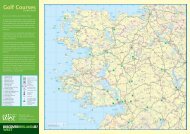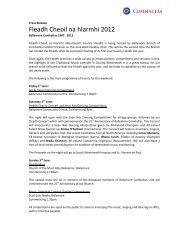Free Guide - Discover Ireland
Free Guide - Discover Ireland
Free Guide - Discover Ireland
You also want an ePaper? Increase the reach of your titles
YUMPU automatically turns print PDFs into web optimized ePapers that Google loves.
Drogheda proper began as an Anglo-Norman<br />
port founded by Hugh de Lacy after whom<br />
the de Lacy Bridge in the town is named.<br />
Around 1180 as two settlements on opposite<br />
banks of the Boyne estuary, downstream<br />
from the ford from which it gets it name.<br />
Drogheda was granted its charter in 1194.<br />
The Anglo-Normans made Drogheda one of<br />
their primary strongholds, completing the<br />
town walls in the mid 13th century. The walls<br />
enclosed and fortified an area of 43 hectares,<br />
north and south of the Boyne, making it<br />
one of the largest walled towns in Medieval<br />
<strong>Ireland</strong>. Drogheda-in-Louth was the larger<br />
of the two towns with a walled area of 32<br />
hectares. After years of conflict and rivalry,<br />
the two boroughs were conjoined as a single<br />
town in 1412, and in 1898 the southern<br />
portion of the town was transferred from<br />
Co. Meath to Co. Louth.<br />
St. Laurence’s Gate, which led to the Friary of<br />
St Laurence, is widely regarded as one of the<br />
finest of its kind in Europe. It consists of two<br />
lofty circular towers, connected together by<br />
a wall, in which there is an archway. It was<br />
originally known as the east gate but it was<br />
renamed in the 14th century because the<br />
street led to the Hospital of St. Laurence.<br />
Visitors can appreciate the spectacular<br />
dimensions of the medieval walls south of<br />
the gate at Featherbed Lane. Twice the walls<br />
and gates of Drogheda held strong against<br />
invasion, firstly when Edward Bruce attacked<br />
the town in 1317 and again in 1642 when Sir<br />
Phelim O’Neill attempted to take Drogheda.<br />
In 1494 Parliament met at Drogheda and<br />
enacted the infamous Poynings’ Law,<br />
(introduced by Lord Deputy Edward Poynings)<br />
which subjected the Irish Parliament to<br />
the control of the English king and council.<br />
Poynings’ Law remained in force until 1801<br />
when The Act of Union made it redundant.<br />
In 1649 Cromwell breached the walls and<br />
sacked the town, massacring 3,500 soldiers,<br />
civilians and clergy, and deporting captives<br />
as slaves to Barbados. Drogheda surrendered<br />
to King William after the Battle of the Boyne<br />
in 1690. Millmount Tower & Museum and St.<br />
Peter’s Church, housing the shrine of St Oliver<br />
Plunkett are also within the town.<br />
Did you know … Drogheda, having recently<br />
surpassed its near neighbour Dundalk, is the<br />
largest town in <strong>Ireland</strong> with just over 35,000<br />
inhabitants (2006 Census). The Boyne Viaduct<br />
at Drogheda is <strong>Ireland</strong>’s greatest example of<br />
Victorian industrial architecture. The bridge,<br />
which carries the Dublin-Belfast railway line,<br />
was opened in 1855.<br />
Contact Details:<br />
Drogheda Tourist Office<br />
Drogheda, Co. Louth<br />
T: + 353 (0) 41 983 2843<br />
E: droghedatouristoffice@gmail.com<br />
Drogheda<br />
FOR OPENING TIMES AND ADMISSION DETAILS PLEASE SEE PULL OUT INSERT AT THE BACK 39

















